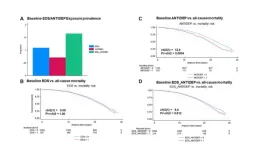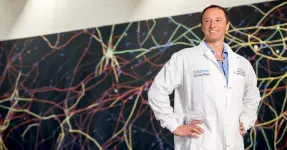(Press-News.org) Embargoed for release until 5:00 p.m. ET on Monday 10 June 2024
Annals of Internal Medicine Tip Sheet
@Annalsofim
Below please find summaries of new articles that will be published in the next issue of Annals of Internal Medicine. The summaries are not intended to substitute for the full articles as a source of information. This information is under strict embargo and by taking it into possession, media representatives are committing to the terms of the embargo not only on their own behalf, but also on behalf of the organization they represent.
----------------------------
1. Passive heat exposure increases stress on the heart, posing risk to adults with history of CAD
Abstract: https://www.acpjournals.org/doi/10.7326/M24-3504
Editorial: https://www.acpjournals.org/doi/10.7326/M24-0882
URL goes live when the embargo lifts
A laboratory controlled experiment including both healthy adults and adults with coronary artery disease (CAD) found that passive heat exposure was enough to increase myocardial blood flow (MBF) in all participants, regardless of age and health status, creating significant stress on the heart. The authors observed asymptomatic heat-induced myocardial ischemia in some participants with CAD, suggesting that these adults may benefit from minimizing cardiac strain during extreme heat by staying cool. The study is published in Annals of Internal Medicine.
Researchers from the Montreal Heart Institute conducted an experimental study comprised of 20 healthy young adults, 21 healthy older adults, and 20 older adults with CAD to quantify the MBF requirements of heat exposure. In a laboratory setting, participants were heated until their core temperature increased 1.5 degrees Celsius (C), and their MBF was measured before exposure and at every increase of 0.5 degrees C to their core temperature. The authors found that MBF increased in all participants when their body temperature increased by 1.5 degrees C. The authors additionally observed that 7 participants with CAD experienced asymptomatic heat-induced myocardial ischemia based on imaging evidence.
An accompanying editorial from Annals of Internal Medicine and the University of Pennsylvania Perelman School of Medicine puts the study findings in context. Given the global rise in average temperature, which has increased heat-related morbidity and mortality, identifying susceptible individuals, including those with obstructive coronary epicardial stenosis or microvascular dysfunction, is imperative. Heat exposure can cause significant stress on the heart leading to a supply–demand mismatch in vessels exhibiting flow-limiting disease. If sustained in time or potentially with repeated exposures, this can result in symptomatic or silent ischemia and explain, at least in part, the increased risk for adverse cardiovascular events observed with heat exposure in population studies. The authors advise that physicians counsel at-risk patients about the harms of excess temperature, including how to identify hyperthermia and the importance of adopting preventive measures.
Media contacts: For an embargoed PDF, please contact Angela Collom at acollom@acponline.org. To speak with the corresponding author, Daniel Gagnon, PhD, please contact Genevieve Bettez at Genevieve.Bettez@icm-mhi.org.
----------------------------
2. Short-term side effects after COVID-19 vaccination associated with greater antibody response
Abstract: https://www.acpjournals.org/doi/10.7326/M23-2956
URL goes live when the embargo lifts
A study of newly vaccinated adults found that short-term side effects after vaccination were associated with greater long-lasting neutralizing antibody (nAB) responses. The study is published in Annals of Internal Medicine.
Researchers from the University of California, San Francisco conducted a prospective cohort study of 363 persons who had not been vaccinated against or exposed to SARS-CoV-2, who then received 2 doses of either BNT162b2 or mRNA-1273. The authors found that the presence of chills, tiredness, feeling unwell, and headache after the second dose were each associated with 1.4- to 1.6-fold higher nAB at 1 and 6 months after vaccination. They also found that each 1-degree Celsius increase in skin temperature after dose 2 was associated with 1.8-fold higher nAB 1 month later and 3.1-fold higher nAB 6 months later. The authors say that their findings may be relevant in addressing negative attitudes toward vaccine side effects, which are a barrier to vaccine uptake.
Media contacts: For an embargoed PDF, please contact Angela Collom at acollom@acponline.org. To speak with any of the corresponding authors, please contact Suzanne Leigh at Suzanne.Leigh@ucsf.edu.
----------------------------
3. Physicians debate best management strategy for patient with type 2 diabetes and CKD
‘Beyond the Guidelines’ features are based on the Department of Medicine Grand Rounds at Beth Israel Deaconess Medical Center
Abstract: https://www.acpjournals.org/doi/10.7326/M24-0764
URL goes live when the embargo lifts
In a new Annals ‘Beyond the Guidelines’ feature, an endocrinologist and a nephrologist discuss controversies regarding the care of patients with type 2 diabetes (T2D) and chronic kidney disease (CKD) and how they would apply the consensus statement to the care of an individual patient with T2D who is unaware that he has CKD. All ‘Beyond the Guidelines’ features are based on the Department of Medicine Grand Rounds at Beth Israel Deaconess Medical Center (BIDMC) in Boston and include print, video, and educational components published in Annals of Internal Medicine.
Concomitant with rising rates of obesity, the prevalence of T2D in the United States continues to increase, especially in certain ethnic and racial groups. While approximately one third of persons with T2D will develop CKD over their lifetime, nearly half of such persons are not receiving guideline-based screening for CKD. In 2022, the ADA and KDIGO published a consensus statement based on high-quality RCTs that recommended annual CKD screening for patients with T2D beginning at the time of diagnosis, discussed the role of therapeutic lifestyle changes to slow progression of CKD and minimize morbidity, and proposed a framework for the rational use of novel pharmacotherapeutic agents for patients with T2D and CKD to improve renal and cardiovascular outcomes.
BIDMC Grand Rounds discussants, Giulio R. Romeo, MD, Assistant Professor of Medicine at Harvard Medical School, a member of the Division of Endocrinology, Diabetes & Metabolism at Beth Israel Deaconess Medical Center, and Associate Medical Director, Adult Diabetes Section, at Joslin Diabetes Center, Boston, Mass., and Sylvia E. Rosas, MD, MSCE Associate Professor of Medicine at Harvard Medical School, a member of the Division of Nephrology at Beth Israel Deaconess Medical Center, and Director of the Latino Kidney Clinic at Joslin Diabetes Center, Boston, Mass., recently debated the case of a 68-year old man with both T2D and CKD.
In their assessment, both Drs. Romeo and Rosas both expressed concern about the lack of guideline-based screening for CKD among persons with T2D in real-world settings. Dr. Romeo discusses clinical trials that demonstrate that early detection and treatment of T2D can reduce diabetes-related complications including renal morbidity. Dr. Rosas points out that many patients with T2D and CKD who are at risk for future kidney failure are unaware of their CKD diagnosis. Dr. Romeo presented data that treatment with SGLT2i reduces the rate of CKD progression and that the benefit is not mediated primarily by improved glycemic control. He notes that treatment with GLP-1RA reduces albumin to creatinine ratio (ACR) but to date has not been shown to slow eGFR decline. Dr. Romeo notes that combination therapy with SGLTi and GLP-1RA reduces cardiovascular morbidity to a greater extent than either alone. Dr. Rosas presented data from seminal trials of SGLTi therapies in patients with CKD and concluded that at least 3 available SGLTi reduce composite outcomes that include reduction of eGFR by at least 50%, onset of ESRD, and death due to cardiovascular or renal causes. In addition, Dr. Rosas notes that finerenone, an ns-MRA, reduced CKD progression and a composite cardiovascular outcome in patients with T2D and CKD. Both Drs. Romeo and Rosas emphasized the importance of multidisciplinary care for selected patients with T2D and CKD.
A complete list of ‘Beyond the Guidelines’ topics is available at www.annals.org/grandrounds.
Media contacts: For an embargoed PDF, please contact Angela Collom at acollom@acponline.org. For an interview with the discussants, please contact Kendra McKinnon at kmckinn1@bidmc.harvard.edu.
----------------------------
END
Passive heat exposure increases stress on the heart, posing risk to adults with history of CAD
2024-06-10
ELSE PRESS RELEASES FROM THIS DATE:
Feeling rough after your COVID shot? Congrats, it’s working!
2024-06-10
Feeling Rough After Your COVID Shot? Congrats, It’s Working!
Headache, chills, tiredness may be evidence of a supercharged defense, according to UCSF-led study.
Fewer than 1 in 4 people in the United States have received last year’s updated COVID-19 vaccine, despite a death toll of more than 23,000 Americans this year.
One of the most common reasons for bypassing the COVID vaccine is concern about side effects like tiredness, muscle and joint pain, chills, headache, fever, nausea and feeling generally unwell. But a new study, led by UC San Francisco, has found that the symptoms indicate a robust immune response that is likely to ...
Depression, antidepressants, epigenetic age acceleration, and mortality in postmenopausal women
2024-06-10
“The study examined the impact of depressive symptoms, antidepressant use, and epigenetic age acceleration on all-cause mortality in postmenopausal women.”
BUFFALO, NY- June 10, 2024 – A new research paper was published in Aging (listed by MEDLINE/PubMed as "Aging (Albany NY)" and "Aging-US" by Web of Science) Volume 16, Issue 10, entitled, “Relationships of depression and antidepressant use with epigenetic age acceleration and all-cause mortality among postmenopausal women.”
In this new study, researchers May A. Beydoun, Hind A. Beydoun, Jason Ashe, Michael F. Georgescu, Steve Horvath, Ake Lu, Anthony S. Zannas, ...
Researchers engineer new approach for controlling thermal emission
2024-06-10
UNIVERSITY PARK, Pa. — If a material absorbs light, it will heat up. That heat must go somewhere, and the ability to control where and how much heat is emitted can protect or even hide such devices as satellites. An international team of researchers, including those from Penn State, has developed a novel method for controlling this thermal emission, with what they called promising implications for thermal management and thermal camouflage technologies.
The team published their work on June 7 in the print edition of Science.
Led by researchers at The University of Manchester’s National Graphene Institute ...
UTA honors two faculty for distinguished scholarship
2024-06-10
The University of Texas at Arlington is honoring two faculty for their outstanding contributions to scholarship with the Distinguished Record of Research or Creativity Award.
Sam W. Haynes, professor of history, and Jaehoon Yu, professor of physics, are the 2024 recipients of the award, which recognizes faculty who have achieved a distinguished record of scholarship over an extended period.
“Jae and Sam have each been at UTA for more than 20 years, and they have each truly made an impact in the lives of the students we prepare for future careers,” said Kate C. Miller, vice president of research and innovation. "In addition, their contributions ...
New research describes the leisure motivations that underpin young U.S. adults' recreational cannabis use
2024-06-10
As of 2024, 24 states including Virginia and Maryland, and DC have legalized the adult recreational use of cannabis. As laws change, citizens' perceptions of the drug and reasons for using the drug have also shifted. In 2020, 34.5% of adults aged 18-25 reported using cannabis in the previous 12 months, according to the Substance Abuse and Mental Health Services Administration. Health experts seek to better understand the broader implications of legalizations and individuals’ motivations and attitudes related to cannabis use.
New ...
UC San Diego develops first-in-kind protocol for creating ‘wired miniature brains’
2024-06-10
Researchers worldwide can now create highly realistic brain cortical organoids — essentially miniature artificial brains with functioning neural networks — thanks to a proprietary protocol released this month by researchers at the University of California San Diego.
The new technique, published in Nature Protocols, paves the way for scientists to perform more advanced research regarding autism, schizophrenia and other neurological disorders in which the brain’s structure is usually typical, but electrical activity is altered. That’s according to Alysson Muotri, Ph.D., corresponding author and ...
Lone Star State: Tracking a low-mass star as it speeds across the Milky Way
2024-06-10
It may seem like the Sun is stationary while the planets in its orbit are moving, but the Sun is actually orbiting around the Milky Way galaxy at an impressive rate of about 220 kilometers per second — almost half a million miles per hour. As fast as that may seem, when a faint red star was discovered crossing the sky at a noticeably quick pace, scientists took notice.
Thanks to the efforts of a citizen science project called Backyard Worlds: Planet 9 and a team of astronomers from around the country, a rare hypervelocity ...
Researchers demonstrate the first chip-based 3D printer
2024-06-10
CAMBRIDGE, MA – Imagine a portable 3D printer you could hold in the palm of your hand. The tiny device could enable a user to rapidly create customized, low-cost objects on the go, like a fastener to repair a wobbly bicycle wheel or a component for a critical medical operation.
Researchers from MIT and the University of Texas at Austin took a major step toward making this idea a reality by demonstrating the first chip-based 3D printer. Their proof-of-concept device consists of a single, millimeter-scale photonic ...
Making remanufacturing profitable
2024-06-10
Returning end-of-life products to as-new condition is called remanufacturing and can be an essential element in a circular economy. But for more industrial companies to take an interest in it, remanufacturing needs to be economically viable. In a doctoral thesis from Linköping University, Johan Vogt Duberg has investigated how this can be accomplished.
“It’s possible to take advantage of increased environmental awareness to gain economic benefits. With remanufacturing, the costs of raw materials can be reduced, new customer groups found and ...
NSF awards additional $9.8 Million for Delta, DeltaAI
2024-06-10
The National Center for Supercomputing Applications was recently awarded $4.9 million of supplemental funding from the U.S. National Science Foundation (NSF) for Delta and an additional $4.9 million for DeltaAI to expand the potential capabilities of the soon-to-launch system by nearly 50 percent.
NCSA originally received nearly $25 million from NSF in 2023 to deploy and operate DeltaAI, an advanced computing and data resource that will be a companion system to Delta. DeltaAI will triple NCSA’s AI-focused computing capacity and ...




